Measurement of CeO2 Nanoparticles in Natural Waters Using a High Sensitivity, Single Particle ICP-MS
Abstract
1. Introduction
2. Results and Discussion
2.1. Optimization of SP-ICP-MS for CeO2 NPs
2.2. Ce-Containing NPs in Natural Waters: Rainwater
2.3. Ce-Containing NPs in Natural Waters: Riverwater
2.4. Effect of Sample Filtration
2.5. Ce-Containing NPs in Natural Waters: Temporal Variations
2.6. Engineered or Natural CeO2 NPs?
3. Materials and Methods
3.1. Engineered NPs
3.2. Sampling and Sample Preparation
3.3. Instrumentation
3.4. SP-ICP-MS Data Acquisition
3.5. SP-ICP-MS Data Processing
4. Conclusions
Supplementary Materials
Author Contributions
Funding
Acknowledgments
Conflicts of Interest
References
- Dahle, J.T.; Arai, Y. Environmental geochemistry of cerium: Applications and toxicology of cerium oxide nanoparticles. Int. J. Environ. Res. Public Health 2015, 12, 1253–1278. [Google Scholar] [CrossRef]
- Sánchez-García, L.; Bolea, E.; Laborda, F.; Cubel, C.; Ferrer, P.; Gianolio, D.; da Silva, I.; Castillo, J. Size determination and quantification of engineered cerium oxide nanoparticles by flow field-flow fractionation coupled to inductively coupled plasma mass spectrometry. J. Chromatogr. A 2016, 1438, 205–215. [Google Scholar] [CrossRef] [PubMed]
- Speed, D.; Westerhoff, P.; Sierra-Alvarez, R.; Draper, R.K.; Pantano, P.; Aravamudhan, S.; Chen, K.L.; Hristovski, K.; Herckes, P.; Bi, X.; et al. Physical, chemical, and in vitro toxicological characterization of nanoparticles in chemical mechanical planarization suspensions used in the semiconductor industry: Towards environmental health and safety assessments. Environ. Sci. Nano 2015, 2, 227–244. [Google Scholar] [CrossRef]
- Sahu, T.; Bisht, S.S.; Das, K.; Kerkar, S. Nanoceria: Synthesis and biomedical applications. Curr. Nanosci. 2013, 9, 588–593. [Google Scholar] [CrossRef]
- Cornelis, G.; Ryan, B.; McLaughlin, M.J.; Kirby, J.K.; Beak, D.; Chittleborough, D. Solubility and batch retention of CeO2 nanoparticles in soils. Environ. Sci. Technol. 2011, 45, 2777–2782. [Google Scholar] [CrossRef]
- Auffan, M.; Masion, A.; Labille, J.; Diot, M.-A.; Liu, W.; Olivi, L.; Proux, O.; Ziarelli, F.; Chaurand, P.; Geantet, C.; et al. Long-term aging of a CeO2 based nanocomposite used for wood protection. Environ. Pollut. 2014, 188, 1–7. [Google Scholar] [CrossRef]
- Dan, Y.; Ma, X.; Zhang, W.; Liu, K.; Stephan, C.; Shi, H. Single particle ICP-MS method development for the determination of plant uptake and accumulation of CeO2 nanoparticles. Anal. Bioanal. Chem. 2016, 408, 5157–5167. [Google Scholar] [CrossRef]
- Azimzada, A.; Farner, J.M.; Hadioui, M.; Liu-Kang, C.; Jreije, I.; Tufenkji, N.; Wilkinson, K.J. Release of TiO2 nanoparticles from painted surfaces in cold climates: Characterization using a high sensitivity single-particle ICP-MS. Environ. Sci. Nano 2020, 7, 139–148. [Google Scholar] [CrossRef]
- Clar, J.G.; Platten, W.E.; Baumann, E.J.; Remsen, A.; Harmon, S.M.; Bennett-Stamper, C.L.; Thomas, T.A.; Luxton, T.P. Dermal transfer and environmental release of CeO2 nanoparticles used as UV inhibitors on outdoor surfaces: Implications for human and environmental health. Sci. Total. Environ. 2018, 613–614, 714–723. [Google Scholar] [CrossRef]
- Scifo, L.; Chaurand, P.; Bossa, N.; Avellan, A.; Auffan, M.; Masion, A.; Angeletti, B.; Kieffer, I.; Labille, J.; Bottero, J.-Y.; et al. Non-linear release dynamics for a CeO2 nanomaterial embedded in a protective wood stain, due to matrix photo-degradation. Environ. Pollut. 2018, 241, 182–193. [Google Scholar] [CrossRef]
- Keller, A.A.; Lazareva, A. Predicted releases of engineered nanomaterials: From global to regional to local. Environ. Sci. Technol. Lett. 2014, 1, 65–70. [Google Scholar] [CrossRef]
- Limbach, L.K.; Bereiter, R.; Müller, E.; Krebs, R.; Gä;lli, R.; Stark, W.J. Removal of oxide nanoparticles in a model wastewater treatment plant: Influence of agglomeration and surfactants on clearing efficiency. Environ. Sci. Technol. 2008, 42, 5828–5833. [Google Scholar] [CrossRef] [PubMed]
- Tan, Z.; Yin, Y.-G.; Guo, X.-R.; Amde, M.; Moon, M.H.; Liu, J.; Jiang, G.-B. Tracking the transformation of nanoparticulate and ionic silver at environmentally relevant concentration levels by hollow fiber flow field-flow fractionation coupled to ICPMS. Environ. Sci. Technol. 2017, 51, 12369–12376. [Google Scholar] [CrossRef] [PubMed]
- Proulx, K.; Hadioui, M.; Wilkinson, K.J. Separation, detection and characterization of nanomaterials in municipal wastewaters using hydrodynamic chromatography coupled to ICPMS and single particle ICPMS. Anal. Bioanal. Chem. 2016, 408, 5147–5155. [Google Scholar] [CrossRef] [PubMed]
- Laborda, F.; Bolea, E.; Jiménez-Lamana, J. Single particle inductively coupled plasma mass spectrometry: A powerful tool for nanoanalysis. Anal. Chem. 2014, 86, 2270–2278. [Google Scholar] [CrossRef] [PubMed]
- Birbaum, K.; Brogioli, R.; Schellenberg, M.; Martinoia, E.; Stark, W.J.; Günther, D.; Limbach, L.K. No evidence for cerium dioxide nanoparticle translocation in maize plants. Environ. Sci. Technol. 2010, 44, 8718–8723. [Google Scholar] [CrossRef]
- Roh, J.-Y.; Park, Y.-K.; Park, K.; Choi, J. Ecotoxicological investigation of CeO2 and TiO2 nanoparticles on the soil nematode Caenorhabditis elegans using gene expression, growth, fertility, and survival as endpoints. Environ. Toxicol. Pharmacol. 2010, 29, 167–172. [Google Scholar] [CrossRef]
- Hadioui, M.; Knapp, G.; Azimzada, A.; Jreije, I.; Frechette-Viens, L.; Wilkinson, K.J. Lowering the Size Detection Limits of Ag and TiO2 Nanoparticles by Single Particle ICP-MS. Anal. Chem. 2019, 91, 13275–13284. [Google Scholar] [CrossRef]
- Fréchette-Viens, L.; Hadioui, M.; Wilkinson, K.J. Quantification of ZnO nanoparticles and other Zn containing colloids in natural waters using a high sensitivity single particle ICP-MS. Talanta 2019, 200, 156–162. [Google Scholar] [CrossRef]
- Hadioui, M.; Peyrot, C.; Wilkinson, K.J. Improvements to single particle ICPMS by the online coupling of ion exchange resins. Anal. Chem. 2014, 86, 4668–4674. [Google Scholar] [CrossRef]
- Abad-Álvaro, I.; Peña-Vázquez, E.; Bolea, E.; Bermejo-Barrera, P.; Castillo, J.R.; Laborda, F. Evaluation of number concentration quantification by single-particle inductively coupled plasma mass spectrometry: Microsecond vs. millisecond dwell times. Anal. Bioanal. Chem. 2016, 408, 5089–5097. [Google Scholar] [CrossRef] [PubMed]
- Donovan, A.R.; Adams, C.D.; Ma, Y.; Stephan, C.; Eichholz, T.; Shi, H. Detection of zinc oxide and cerium dioxide nanoparticles during drinking water treatment by rapid single particle ICP-MS methods. Anal. Bioanal. Chem. 2016, 408, 5137–5145. [Google Scholar] [CrossRef] [PubMed]
- US Research Nanomaterials, I. Cerium Oxide Nanopowder/Nanoparticles. Available online: https://www.us-nano.com/inc/sdetail/214 (accessed on 1 November 2019).
- Thorp, J.; Lamberti, G.; Casper, A. St. Lawrence River Basin; Elsevier academic press: Burlington, MA, USA, 2005; pp. 982–1028. [Google Scholar]
- O’Brien, N.; Cummins, E. Nano-scale pollutants: Fate in irish surface and drinking water regulatory systems. Hum. Ecol. Risk Assess. Int. J. 2010, 16, 847–872. [Google Scholar] [CrossRef]
- Gottschalk, F.; Sun, T.; Nowack, B. Environmental concentrations of engineered nanomaterials: Review of modeling and analytical studies. Environ. Pollut. 2013, 181, 287–300. [Google Scholar] [CrossRef]
- Peters, R.J.B.; Van Bemmel, G.; Milani, N.B.; Hertog, G.C.D.; Undas, A.K.; van der Lee, M.; Bouwmeester, H. Detection of nanoparticles in Dutch surface waters. Sci. Total. Environ. 2018, 621, 210–218. [Google Scholar] [CrossRef]
- Oriekhova, O.; Stoll, S. Stability of uncoated and fulvic acids coated manufactured CeO2 nanoparticles in various conditions: From ultrapure to natural Lake Geneva waters. Sci. Total. Environ. 2016, 562, 327–334. [Google Scholar] [CrossRef]
- Ramirez, L.; Gentile, S.R.; Zimmermann, S.; Stoll, S. Behavior of TiO2 and CeO2 nanoparticles and polystyrene nanoplastics in bottled mineral, drinking and lake geneva waters. impact of water hardness and natural organic matter on nanoparticle surface properties and aggregation. Water 2019, 11, 721. [Google Scholar] [CrossRef]
- Montaño, M.D.; Lowry, G.V.; von der Kammer, F.; Blue, J.; Ranville, J.F. Current status and future direction for examining engineered nanoparticles in natural systems. Environ. Chem. 2014, 11, 351–366. [Google Scholar] [CrossRef]
- Praetorius, A.; Gundlach-Graham, A.; Goldberg, E.; Fabienke, W.; Navratilova, J.; Gondikas, A.; Kaegi, R.; Günther, D.; Hofmann, T.; von der Kammer, F. Single-particle multi-element fingerprinting (spMEF) using inductively-coupled plasma time-of-flight mass spectrometry (ICP-TOFMS) to identify engineered nanoparticles against the elevated natural background in soils. Environ. Sci. Nano 2017, 4, 307–314. [Google Scholar] [CrossRef]
- Markus, A.; Krystek, P.; Tromp, P.; Parsons, J.; Roex, E.; de Voogt, P.; Laane, R. Determination of metal-based nanoparticles in the river Dommel in the Netherlands via ultrafiltration, HR-ICP-MS and SEM. Sci. Total. Environ. 2018, 631-632, 485–495. [Google Scholar] [CrossRef]
- Sharma, V.K.; Filip, J.; Zboril, R.; Varma, R.S. Natural inorganic nanoparticles—Formation, fate, and toxicity in the environment. Chem. Soc. Rev. 2015, 44, 8410–8423. [Google Scholar] [CrossRef] [PubMed]
- Vitalij, K.; Karl, A.P.; Gschneidner, J. Rare-Earth Element; Encyclopaedia Britannica, inc.: Chicago, IL, USA, 2019; Available online: https://www.britannica.com/science/rare-earth-element (accessed on 24 November 2020).
- Castor, S.B. Rare Earth Elements. In Industrial Minerals & Rocks; Society for Mining, Metallurgy, and Exploration, Inc.: Littletown, CO, USA, 2006; pp. 769–792. [Google Scholar]
- US Research Nanomaterials, I. Lanthanum Oxide Nanopowder/Nanoparticles. Available online: https://www.us-nano.com/inc/sdetail/965 (accessed on 1 November 2019).
- Azimzada, A.; Farner, J.M.; Jreije, I.; Hadioui, M.; Liu-Kang, C.; Tufenkji, N.; Shaw, P.; Wilkinson, K.J. Single- and multi-element quantification and characterization of TiO2 nanoparticles released from outdoor stains and paints. Front. Environ. Sci. 2020, 8. [Google Scholar] [CrossRef]
- Pace, H.E.; Rogers, N.J.; Jarolimek, C.; Coleman, V.A.; Higgins, C.P.; Ranville, J.F. Determining transport efficiency for the purpose of counting and sizing nanoparticles via single particle inductively coupled plasma mass spectrometry. Anal. Chem. 2011, 83, 9361–9369. [Google Scholar] [CrossRef] [PubMed]
- Shaw, P.; Donard, A. Nano-particle analysis using dwell times between 10 μs and 70 μs with an upper counting limit of greater than 3 × 107 cps and a gold nanoparticle detection limit of less than 10 nm diameter. J. Anal. At. Spectrom. 2016, 31, 1234–1242. [Google Scholar] [CrossRef]
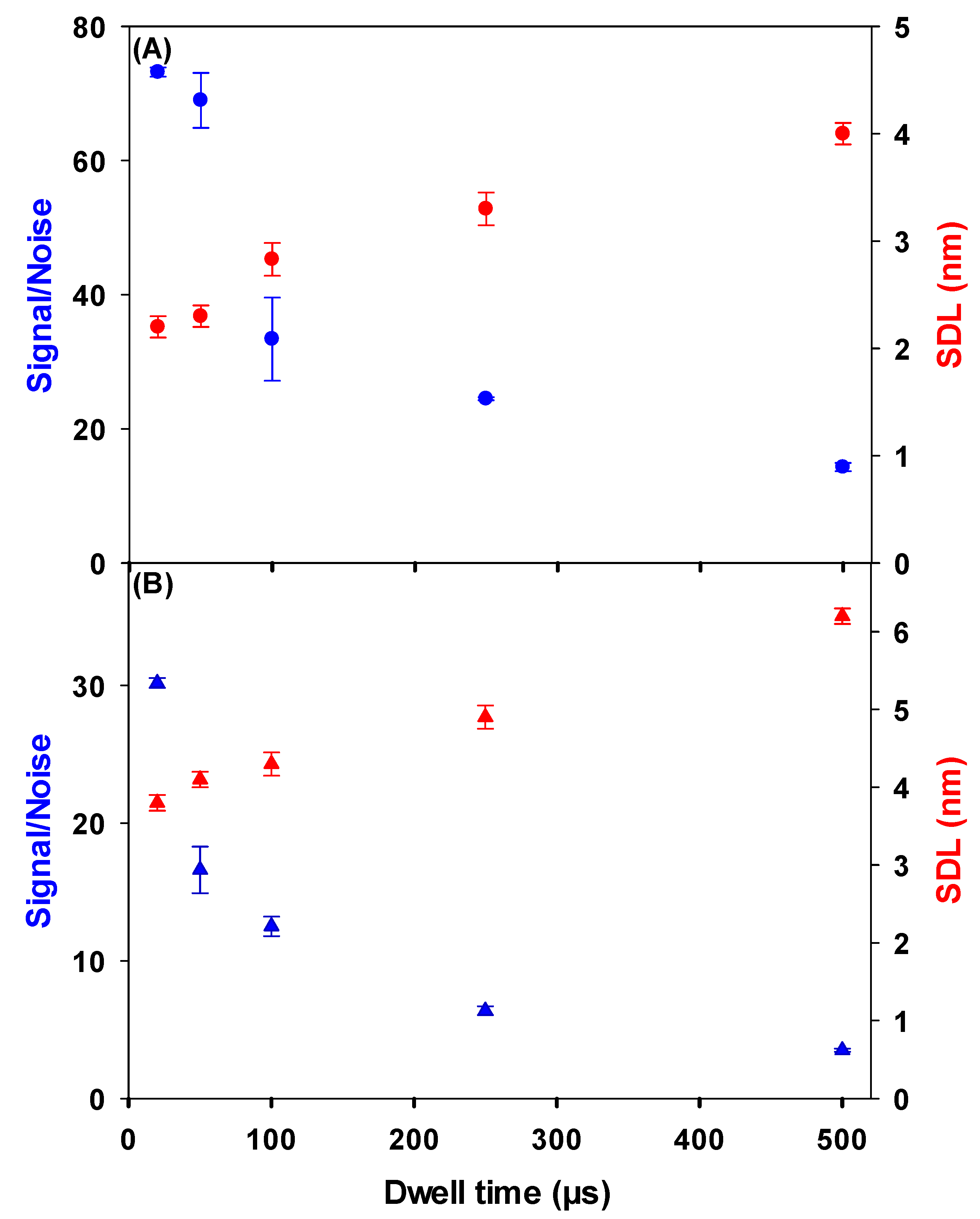
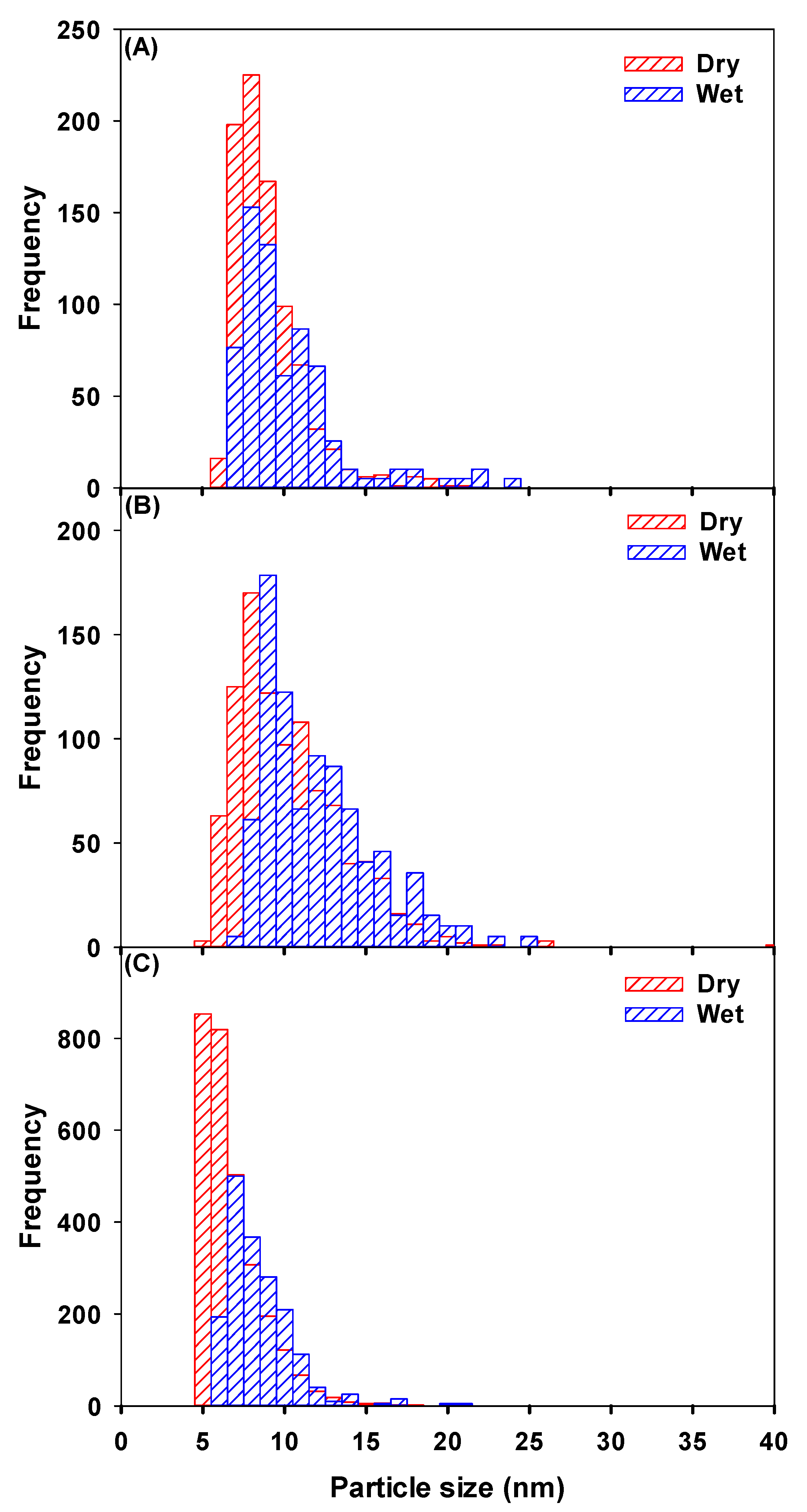
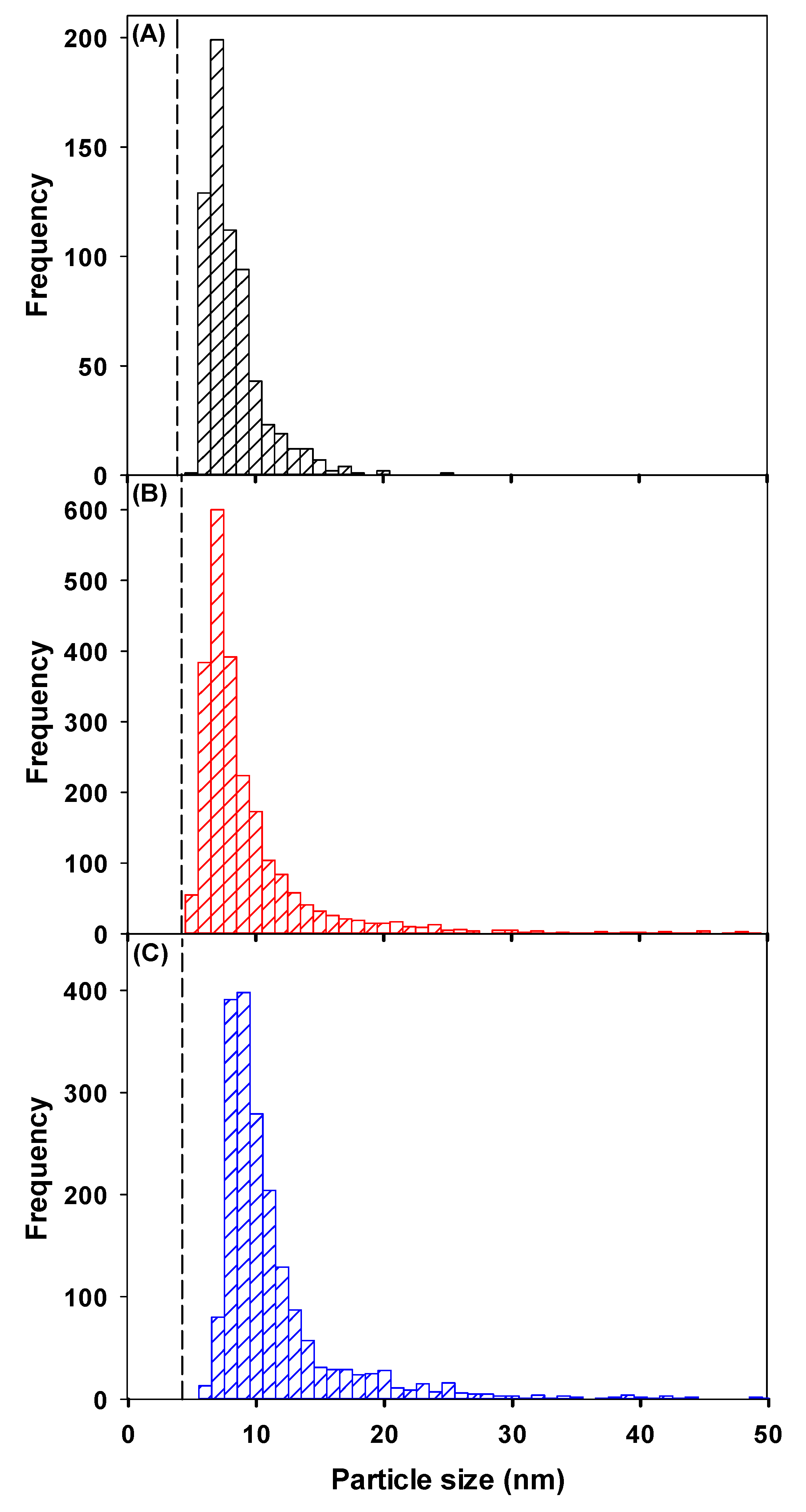
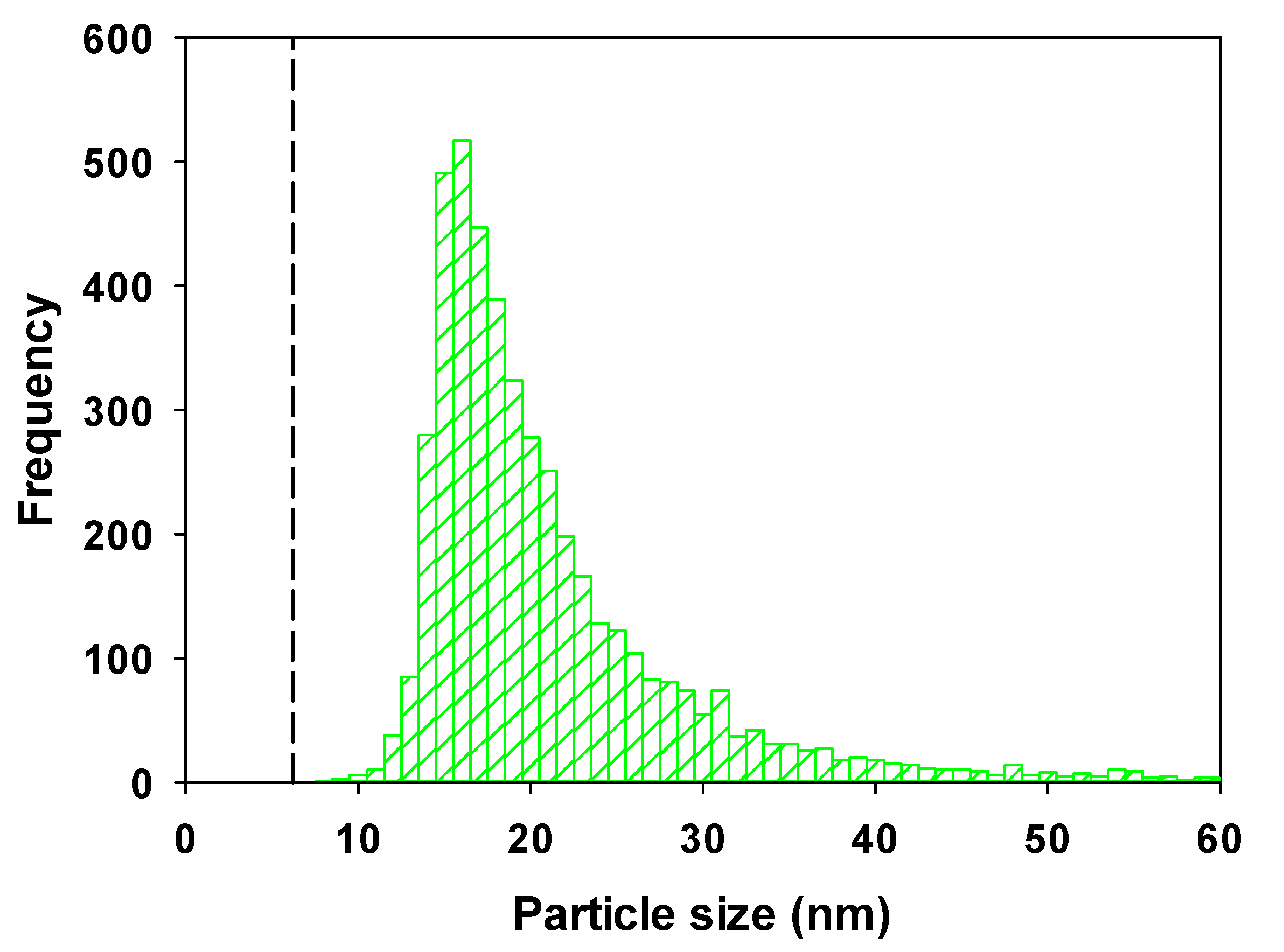
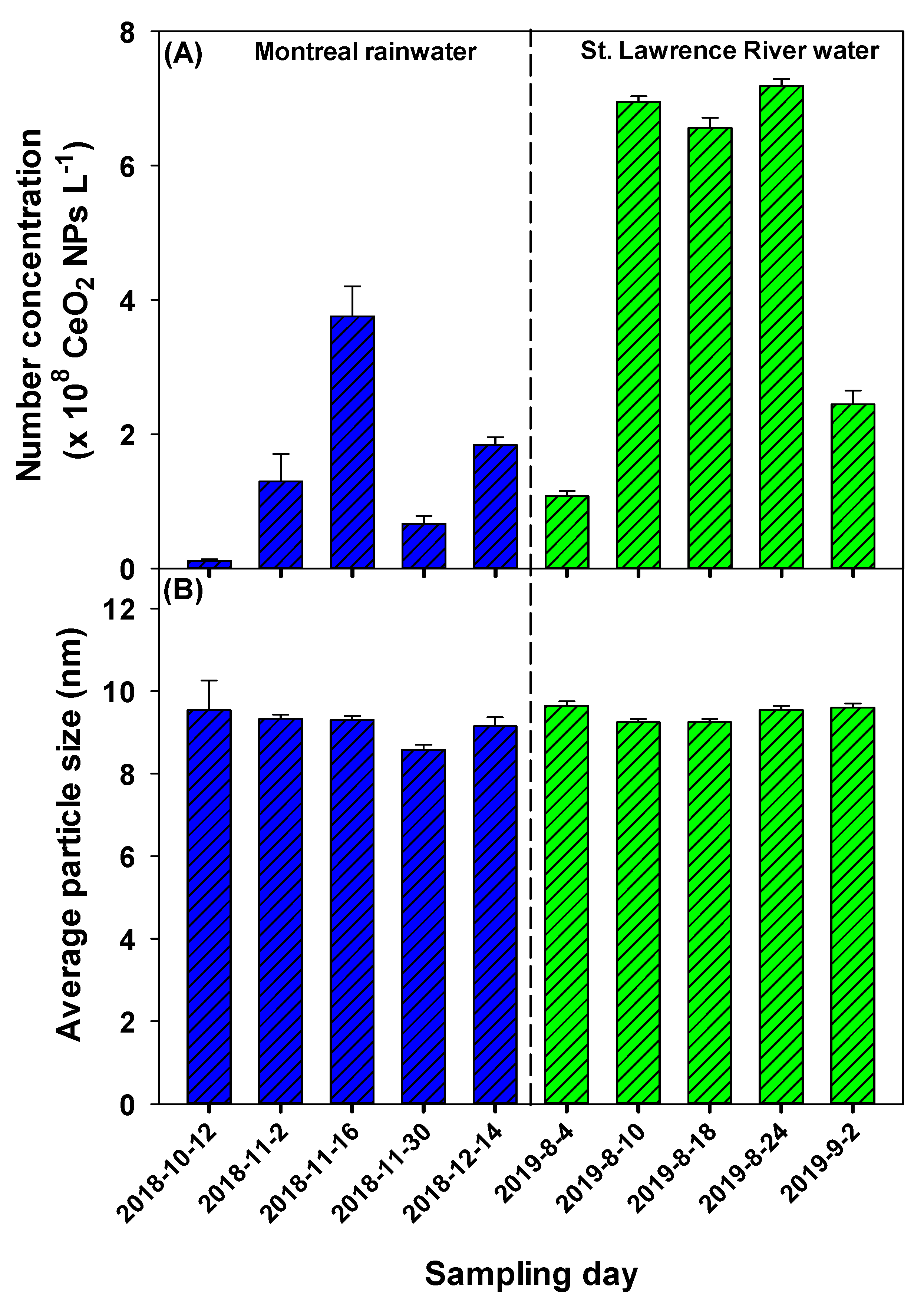
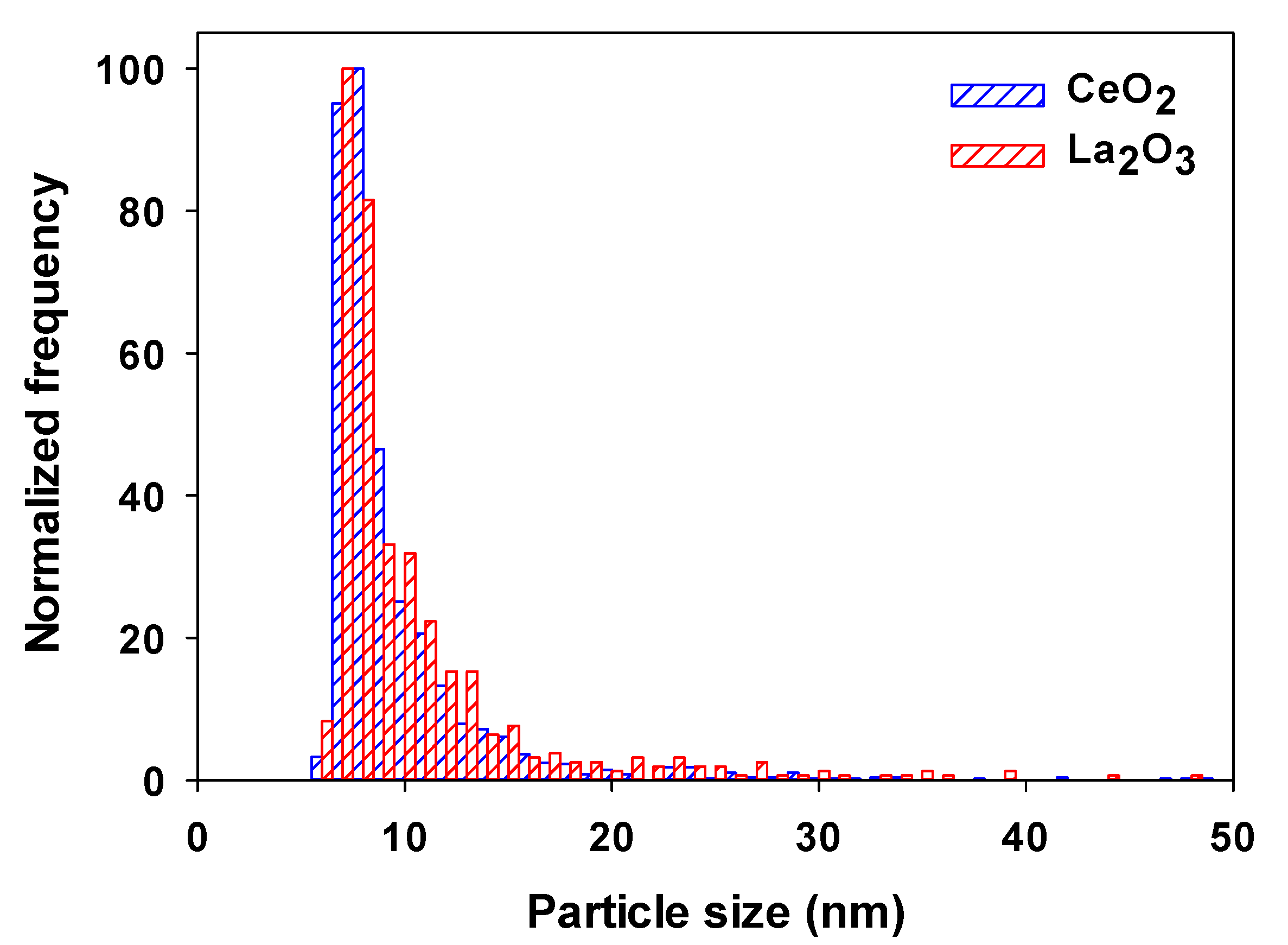
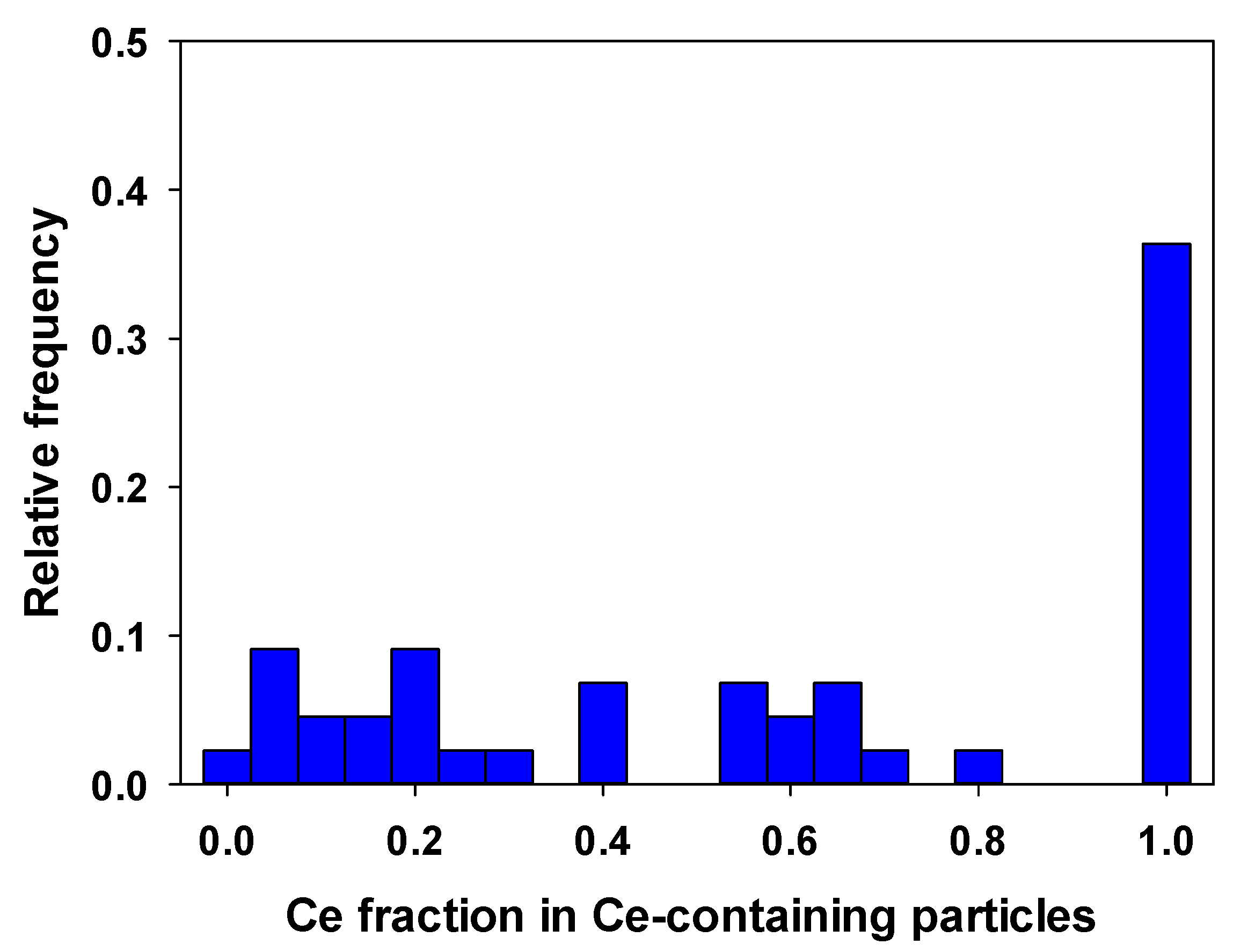
| Analyte | Sensitivity (Counts fg−1) | Nanoparticle | Size Detection Limit (nm) | ||||
|---|---|---|---|---|---|---|---|
| Q-ICP-MS | SF-ICP-MS | Q-ICP-MS | SF-ICP-MS | ||||
| Wet | Dry | Wet | Dry | ||||
| Ag | 50 ± 19 | 4750 ± 1200 | 22,300 ± 2400 | Ag | 16.3 ± 2.1 | 4.7 ± 0.2 | 3.1 ± 0.3 |
| Au | 15 ± 3 | 2900 ± 800 | 13,700 ± 1200 | Au | 19.0 ± 1.0 | 4.4 ± 0.1 | 2.8 ± 0.1 |
| Ce | 72 ± 15 | 14,800 ± 700 | 47,900 ± 8600 | CeO2 | 16.8 ± 1.1 | 4.0 ± 0.2 | 2.3 ± 0.2 |
| NP Suspension | Average Particle Size (nm) | NP Number Concentration (×107 L−1) | SDL (nm) | |||
|---|---|---|---|---|---|---|
| Wet | Dry | Wet | Dry | Wet | Dry | |
| Ag | 9.3 ± 0.4 | 8.5 ± 0.1 | 5.5 ± 0.6 | 7.7 ± 0.2 | 4.6 ± 0.1 | 3.1 ± 0.1 |
| Au | 11.8 ± 0.1 | 9.7 ± 0.1 | 6.6 ± 0.8 | 8.9 ± 0.1 | 4.2 ± 0.1 | 3.1 ± 0.1 |
| CeO2 | 8.0 ± 0.1 | 6.3 ± 0.0 | 20.9 ± 0.4 | 26.3 ± 1.5 | 4.1 ± 0.1 | 2.8 ± 0.1 |
| Water Natural Sample | Mass Concentration of Dissolved Ce (ng L−1) | Number Concentration (×109 CeO2 NPs L−1) | Mass Concentration of CeO2 NPs (ng L−1) | SDL (nm) |
|---|---|---|---|---|
| Montreal rainwater | 4.0 ± 0.1 | 0.22 ± 0.01 | 1.9 ±0.1 | 4.6 ± 0.1 |
| St. Lawrence River | 53 ± 17 | 1.6 ± 0.3 | 107 ± 26 | 6.2 ± 0.6 |
| Water Natural Sample | Fraction of Ce NPs (%) | Fraction of La NPs (%) | Ce NPs/La NPs | Dissolved Ce/Dissolved La | Total Ce/Total La |
|---|---|---|---|---|---|
| Montreal rainwater | 46.3 ± 8.8 | 50.6 ± 3.9 | 2.2 ± 0.6 | 2.6 ± 1.8 | 2.4 ± 2.2 |
Sample Availability: Not available. |
Publisher’s Note: MDPI stays neutral with regard to jurisdictional claims in published maps and institutional affiliations. |
© 2020 by the authors. Licensee MDPI, Basel, Switzerland. This article is an open access article distributed under the terms and conditions of the Creative Commons Attribution (CC BY) license (http://creativecommons.org/licenses/by/4.0/).
Share and Cite
Jreije, I.; Azimzada, A.; Hadioui, M.; Wilkinson, K.J. Measurement of CeO2 Nanoparticles in Natural Waters Using a High Sensitivity, Single Particle ICP-MS. Molecules 2020, 25, 5516. https://doi.org/10.3390/molecules25235516
Jreije I, Azimzada A, Hadioui M, Wilkinson KJ. Measurement of CeO2 Nanoparticles in Natural Waters Using a High Sensitivity, Single Particle ICP-MS. Molecules. 2020; 25(23):5516. https://doi.org/10.3390/molecules25235516
Chicago/Turabian StyleJreije, Ibrahim, Agil Azimzada, Madjid Hadioui, and Kevin J. Wilkinson. 2020. "Measurement of CeO2 Nanoparticles in Natural Waters Using a High Sensitivity, Single Particle ICP-MS" Molecules 25, no. 23: 5516. https://doi.org/10.3390/molecules25235516
APA StyleJreije, I., Azimzada, A., Hadioui, M., & Wilkinson, K. J. (2020). Measurement of CeO2 Nanoparticles in Natural Waters Using a High Sensitivity, Single Particle ICP-MS. Molecules, 25(23), 5516. https://doi.org/10.3390/molecules25235516






